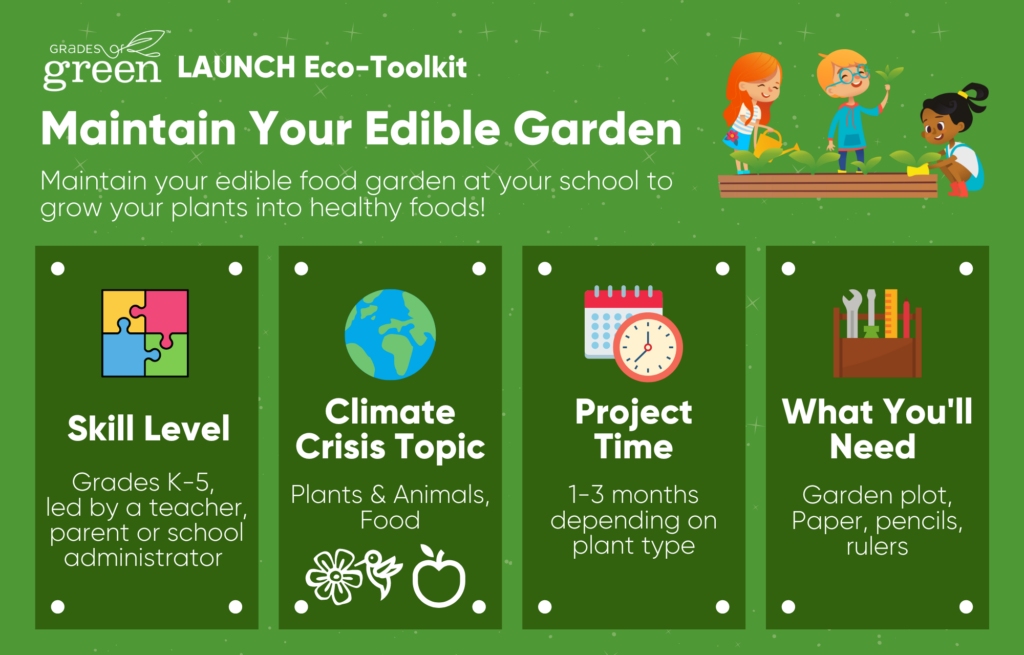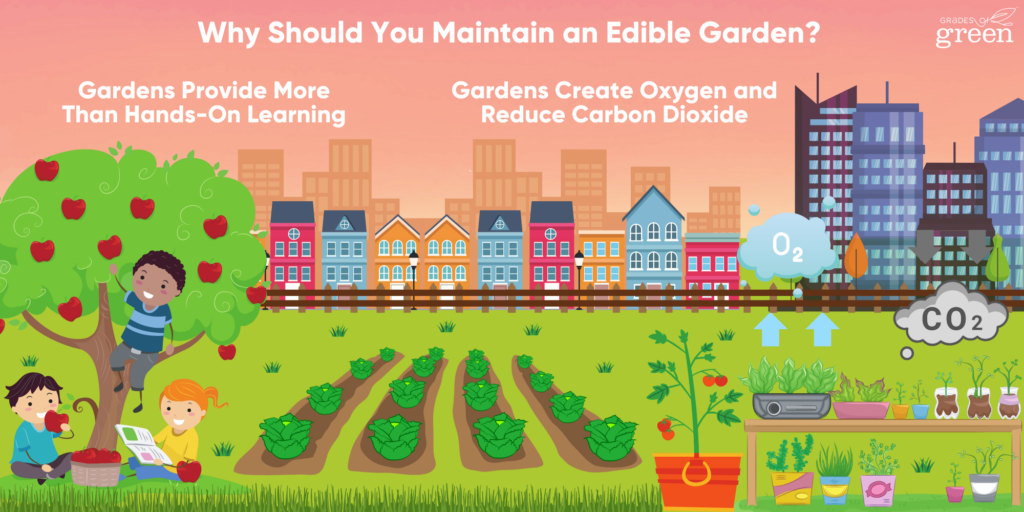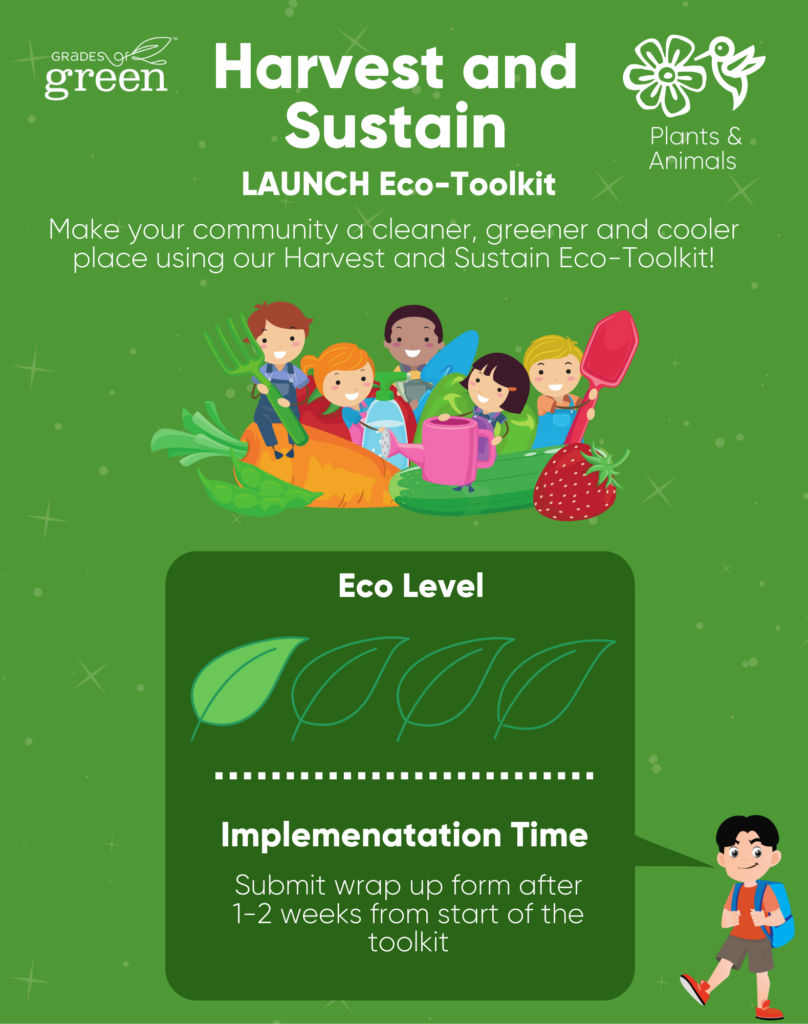Your garden has been planned and planted, now it’s time to MAINTAIN!
A healthy garden requires consistent care and attention. Plants require sunlight, water, and food to grow and create food to eat. In the third toolkit of the Edible Garden series, students will learn how to maintain an edible garden through watering and fertilizing along with pest management and other garden issues. They will also discover the positive impacts edible gardens have on the environment.
Grades of Green is proud to partner with Palos Verdes School Gardens and Kellogg Garden Products to bring you this toolkit.

Toolkit Details


NGSS
This toolkit address the following Science and Engineering Practices (SEPs) within the Performance Expectations of NGSS for Grades: K-2 and 3-5
- Asking Questions and Defining a Problem
- Planning and Carrying out Investigations
- Analyzing and Interpreting Data
- Using Mathematics and Computational Thinking
- Constructing Explanations and Designing Solutions
- Obtaining Evaluating, and Communicating Information
Learning Objectives
- Analysis
- Students will analyze their campus and determine best practices.
- Project Management
- Students will keep track of progress and care for a living plant.
- Students will practice leadership skills by delegating tasks to each other.
- Evaluation and Assessment
- Students will track and evaluate the impact of their project.
What is an Edible Garden & Why is it Important?
An edible garden is a garden where you can eat what you grow! Edible gardens that are organic do not use harmful pesticides (a substance used to remove insects/pests and can also hurt plants and animals). Organic gardens contain healthy soil that removes CO2 from our atmosphere and eliminates dangerous chemicals and toxins that can occur on commercial produce.
What You Will Accomplish
Students will be able to keep their plants growing and thriving in the garden through regular maintenance by watering, weeding, and feeding. So much work has gone into planning and planting, now is the time to ensure all that hard work doesn’t go to waste! Good care will increase the quality and life of the garden so there will be plenty to harvest and enjoy (more on that in the next toolkit!).
Educator Project Plan
Follow the steps below to set up a successful Edible Garden at your school! Need help? Contact us!
Track your metrics and submit your impact after implementing this toolkit. Your feedback helps keep our programs free for all across the globe.
Determine Participants
Use the Edible Garden Sign Up Sheet to have participants sign up. This step is for groups that did not use the Plan and Plant toolkit or do not already have a team together. Skip this step if you already have a team together.
- A Student Group such as (a club, before/after school program, non-school organization)
- A whole class
- The whole school
- An adult garden committee to support the students: Custodial staff, teachers, administrators, parent volunteers
- Working in a small student group? Determine roles for each student
- A Whole class? Divide the class into groups to lead different tasks
- The Whole school? Have a core group of student leaders to implement tasks and educate the rest of the students during an assembly or walking assemblies
Why Should You Maintain an Edible Garden?
The resources provided below can be shown as a slideshow or printed out as individual worksheets for students to review. For more background learning, please refer to the Plan and Plant your garden toolkit!

Gardens Provide More Than Hands On Learning
Having a garden allows children to love and connect with nature. An edible garden is a garden where you can eat what you grow! Organic edible gardens are a more sustainable alternative to conventional gardening. They create healthy soil that removes CO2 from our atmosphere and eliminates dangerous chemicals and toxins that can occur in commercial produce. By using organic fertilizer in the soil and avoiding synthetic fertilizers, herbicides, and pesticides, the microorganisms in the soil that sequester carbon can continue to thrive. Synthetic nitrogen fertilizer can cause emissions of nitrous oxide, a greenhouse gas that is 300 times more potent than carbon dioxide. An organic garden has better soil quality, reducing fertilizer and pesticide run-off pollution. [1]
Gardens Create Oxygen and Reduce Carbon Dioxide
Plants create oxygen for us to breathe and food for us to eat. Carbon dioxide is a gas that increases the warming of the planet but it is also used by plants in photosynthesis. These plants reduce the amount of carbon dioxide that ends up trapped in our atmosphere. The edible garden you have created uses Carbon Dioxide, along with sunlight and water to make energy and release oxygen. Plants can live without people but people cannot live without plants. Plants make the oxygen in the air that we breathe and are essential to life on Earth. [2]
Why Food is a Social Justice Issue
Children in urban environments often have limited access to natural spaces. Food Deserts (or areas where it’s hard to get fresh food and produce) and food swamps (areas that lack fresh food/produce but offer a lot of unhealthy and fast foods) are environmental justice issues. People who live in communities with limited access to fresh produce and whole foods, often consume more processed/fast food than fresh food. These foods take more energy to produce and transport and release carbon emissions unlike their nutritious counterparts – fresh fruits and vegetables. Access to fresh fruits and vegetables to all can not only improve health but it is also better for our planet.
Watch these Short Videos to Learn More on Maintaining a Garden
Think About It!
Pre-Activity Questions
- What will happen if the garden doesn’t get maintained?
- What are the benefits of maintaining a garden?
- Who should you contact if there are issues in the garden?
- What skills can be gained from working in the garden?
- What happens if the plants never get fed?
Take Action: LAUNCH the Maintenance an Edible Garden
Lead students through the Maintain an Edible Garden activity with guided instructions. Check out “Pro Tips” for additional help.
1. Assign Roles and Schedule
Make sure everyone is familiar with what role and responsibility they will have in the garden. Check your maintenance plan from Toolkit #1 and review and update roles if necessary. Use the Edible Garden Series Roles Worksheet to keep track of everyone’s responsibilities in the garden.
Create a schedule using this Edible Garden Maintenance Schedule Worksheet to ensure your garden is properly maintained.
2. Water Your Garden
Water is required for plants to live and grow! Based on your planning, pick a method on how you would like to water your garden. Some of the materials can include the following:
- Watering can
- Hose
- Irrigation system
When watering, here are some best practices to follow that will improve your garden:
- Water in the early morning.
- Water plants at their roots! Wetting the leaves can lead to disease.
- Water thoroughly a few times a week. You want to make sure the soil is wet from 6-8 inches deep. Check with a moisture meter, which can be found at any gardening store.
- Use milk or juice containers with handles to water. They are a great size for kids.
- Place plants with similar watering needs together. Over watering shows up as yellow or brown limp leaves and occurs more often than underwatering.
- Use rain barrels to collect water for the garden. Contact your local water department to see if they can provide a free or discounted rain barrel.
3. Weed Your Garden
A weed is just a plant growing where you don’t want it that takes nutrients, water, or light away from the desired plants. It’s important to know the difference between the weed and the plants that are wanted. Here are some best practices to limit weeds in your garden:
- Prevent weeds before they start
- Maintain healthy soil by keeping the pH balanced
- Plant your garden densely
- Use mulch
- Pull weeds every time you visit the garden or put it on a weekly schedule. This will keep them from growing too large.
If you want more tips on preventing and removing weeds, check out Kill Unwanted Plants Organically.
4. Mulch Your Garden
Mulch is a material that covers the soil. Mulching is an important multipurpose tool for the garden. It can prevent weeds, help retain water in the soil, prevent erosion, stabilize the soil temperature, and provide nutrients as it breaks down.
Types of materials to use for organic mulch
- Compost (Click here to start Composting at School)
- Wood chips
- Shredded leaves
- Grass clippings
- Straw or hay (weed/seed free)
When you are mulching your garden, follow these best practices to make your garden more successful:
- Before you begin mulching make sure the soil is weed free.
- Add a 2-4 inch layer of mulch covering the soil.
- Keep the mulch approximately 1 inch away from plant stems. Piling mulch right up against the plant can cause the stems to rot.
- A volunteer plant (it grows independently without being deliberately planted) is not a weed, but could come from misplaced seeds or compost. If you can determine what type of plants they are (and there is enough room) they could be left in place or moved to a different location. Learn more about volunteer plants here.
- Mulching can slow soil warming, so in spring move it aside for a few weeks to let the soil warm up.
5. Dealing with Pests and Diseases
What is a Pest?
Pests are things that interfere with the desirable plants in the garden. They can transmit disease or may just be difficult to deal with. A pest can be a weed, bird, mammal, insect, pathogen like bacteria, virus, or fungus, or any unwanted thing that might harm parts of the garden ecosystem.
There are many reasons why a plant may die. If the plant shows signs of disease, take it out quickly before the disease spreads. Common garden pests include: Aphids, cutworms, flea beetles, Japanese beetles, striped cucumber beetles, tomato hornworms. Familiarizing yourself with which pest and disease problems you’re likely to encounter is a good first step in coming up with a control plan and will depend on what is planted. A garden that has a good ecosystem will have minimal pest problems. A few pests are manageable. They can be washed off with water or picked off by hand.
While pests can be an issue, there are many bugs that can be beneficial to your garden by eating garden pests or acting as pollinators. It’s important to learn to identify the “good bugs,” some examples are:
- Ladybugs, spiders, praying mantis, bees, wasps, dragonflies, ground beetles, lacewings, soldier beetles, and, spined soldier bugs
- Many pest problems can be solved by doing your research and adding or taking steps to attract the right beneficial bugs to your garden.
- Practice prevention and stop problems before they begin
- Remove diseased plants from the garden quickly to avoid disease spread
- Healthy soil is the foundation for healthy plants
- Regularly add organic matter like compost for soil microbes
- Practice good garden sanitation
- Clean up well at the end of the season
- Don’t compost infected plant material
- Rotate related plants each year
- A three-year cycle is the best
- Monitor soil moisture
- Aim for consistently moist soil
- Avoid wet foliage, this can promote disease
- Choose disease-resistant varieties
- Check the seed packet
- Letters after the plant name like V&F after tomato are resistant to Verticillium and Fusarium wilts
- Keep weeds under control
- Weeds can harbor pests
- Use barriers and traps
- Row covers can stop pests from being a problem for plants that don’t need pollination
Reflection Questions
How’d It Go?
- What was the most challenging part of the maintenance process?
- What changes could be made next time?
- What was your favorite maintenance activity?
Report Students’ Impact
Congratulations!! You’ve Maintained an Edible Garden! Don’t let all that hard work go unnoticed. Submit your results by clicking the green button below.
By reporting your impact, Grades of Green can:
- CELEBRATE and elevate your students’ hard work and success.
- Offer our programs FREE for all students across the globe.
- AWARD stipends and certificates to hard-working educators and students.
Please take a few minutes to submit your results. Thank you!
Next Steps
Congrats on Planning Your Edible Garden! Get started on Toolkit #4: Harvest and Sustain Your Edible Garden!

Provided Resources
- Edible Garden Series Google Resources
- Edible Garden Series Sign Up Sheet
- Edible Garden Series Roles Worksheet
- Edible Garden Maintenance Schedule
- Maintain Your Edible Garden Slides
- Maintain Your Edible Garden Wrap Up Form
Did you enjoy this toolkit? Get ready to harvest your edible garden!